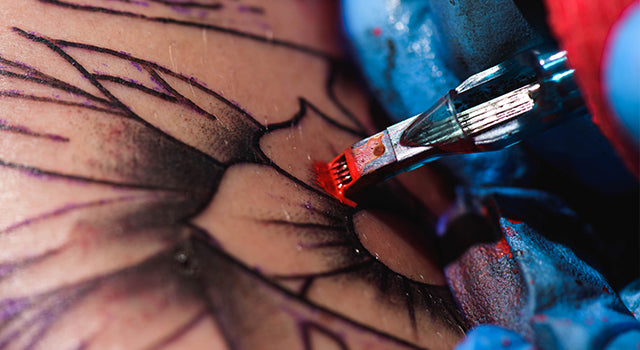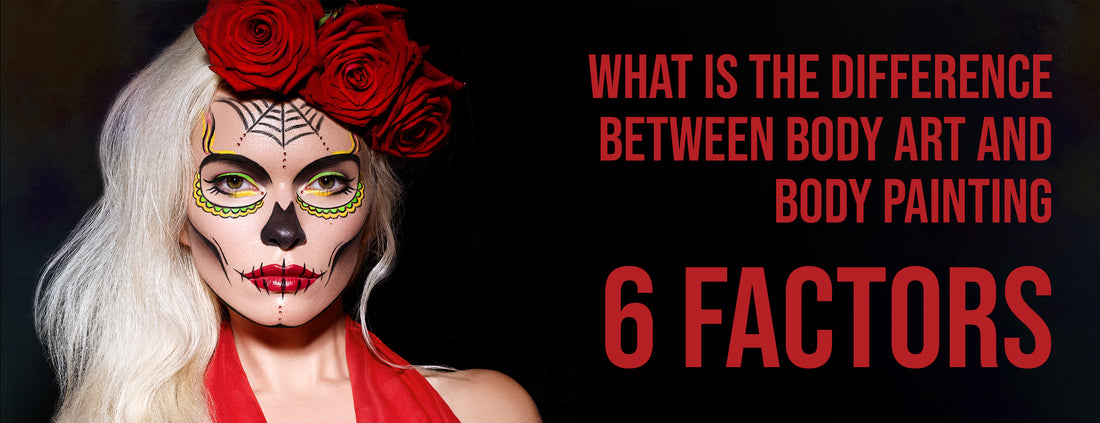In body art, artists use needles and ink to change their client's skin. A tattoo artist, for example, inserts ink into small holes made in the skin quickly using an electric tattoo machine.
The practice of body painting involves painting artwork directly onto the skin. Body painting differs from tattoos because it is temporary, lasting several hours or even a few weeks (mehndi or "henna tattoos," about 2 weeks).
In this blog post, we will explore the significant features of body art and body painting, including their techniques, artistic and cultural purpose, materials, duration, and social acceptance.
What Is the Difference Between Body Art And Body Painting: 6 Factors

Paintings and designs apply to the body as part of body painting and body art. Despite their similarities, they differ significantly. This blog post highlights the key elements that differentiate body art and body painting.
Comparison of Body Painting Techniques and Body Art Techniques
Although many people confuse the two, there are apparent differences between body painting and body art. Here are some differences between the two techniques to better understand the world of body art.
| Body Art Techniques | Body Painting Techniques |
|---|---|
| Tattooing: This involves injecting ink into the skin to create a design. It’s a permanent form of body art. | Brush/Sponge Application: This is the traditional method of body painting where paint is applied using brushes or sponges. |
| Scarification: This technique involves cutting or burning the body to make permanent marks or designs. | Airbrush: This technique uses an airbrush tool to spray paint onto the body, allowing for smooth and detailed designs. |
| Piercing: This involves creating a hole in the body to insert jewelry. This may be temporary or permanent, depending on whether the jewelry is removed. | Henna: This form of body painting uses a dye prepared from the henna plant. It’s temporary but can last up to a few weeks. |

Artistic and Cultural Purpose
They share some similarities but also some distinct differences between them. The following are some comparisons of the artistic and cultural purposes of these two forms of body modification.
| Reasons for Body Art | Reasons for Body Painting |
|---|---|
| Self-expression: Body art is a powerful tool for self-expression. It allows individuals to convey their thoughts, feelings, and experiences uniquely and personally. | Fashion/shows: Body painting is often used in the fashion industry to create stunning visuals for shows, photoshoots, and advertising campaigns. |
| Cultural/religious traditions: Body art is deeply rooted in many cultures and religions. It can symbolize a person’s identity, status, or spiritual beliefs. | Celebrations/festivals: Body painting is a widespread practice during various celebrations and festivals. The festivities are made more fun and exciting with it. |
| Healing/medicinal purposes: Some forms of body art are believed to have healing properties. For instance, acupuncture, a type of body art, has been used in traditional Chinese medicine to improve health and well-being. | Artistic expression: Body painting allows artists to use the human body as a canvas. It’s a form of art that combines creativity with the beauty of the human condition. |
Body Painting and Body Art Materials Comparison

For body art and body painting, the materials used are as diverse as the designs they create. Each material brings something unique to the table, from the permanence of ink and needles to the fleeting beauty of paint and glitter. Let’s look at the materials commonly used in body art and body painting.
| Materials Used for Body Art | Materials Used for Body Painting |
|---|---|
| Ink: Ink is the primary material used in tattooing. It’s injected into the skin to create permanent designs. The ink used in tattoos is typically made from metal salts or plastics. | Paint: Special body paints are used that are safe for the skin. They come in various colors and can be water- or oil-based. |
| Needles: Needles are used in various forms of body art, including tattooing and piercing. They puncture the skin, allowing ink or jewelry to be inserted. | Brushes/Sponges: Brushes and sponges apply the paint to the skin. Different sizes and types of brushes and sponges can achieve other effects. |
| Jewelry: Jewelry is used in body piercings. It can be made from various materials, including surgical steel, titanium, gold, and bio-compatible plastics. | Glitter: Incorporate glitter to give a sparkling effect to body paint designs. It’s typically applied while the body paint is still wet so that it sticks to the skin. |

Comparing the Duration of Body Art Vs Body Painting
When it comes to body art and body painting, one of the key differences lies in their duration. While body art often leaves a lasting mark, body painting is a fleeting expression. Let’s delve into the typical durations of various body painting and body art forms.
| Length of Time Body Art Lasts | Length of Time Body Painting Lasts |
|---|---|
| Tattoos: Tattoos are a form of body art that is permanent. Once the ink is injected into the skin, it stays there for a lifetime. | Temporary Tattoos: Temporary tattoos can last from a few days to a few weeks, depending on the tattoo and how well it’s cared for. |
| Scarification: Scarification involves scratching, etching, or cutting designs into the skin, resulting in scars that form permanent patterns. | Henna: Henna is a form of body painting that involves dye made from henna plants. Henna designs can last 1-2 weeks. |
| Piercings: Piercings are considered semi-permanent. While the holes made by piercings can close up over time if the jewelry is removed, some piercings may leave lasting marks or scars. | Body painting: Traditional body painting typically lasts for a day or two. You can easily remove the paint using soap and water. |
Social Acceptance for Body Art and Body Painting

Body art and body painting hold a unique place in personal expression. They are forms of self-expression that are worn on one’s sleeve. However, the social acceptance of these art forms can vary. Let’s delve into the societal attitudes towards body art and body painting.
| Attitude Towards Body Art | Attitude Towards Body Painting |
|---|---|
| Varies By Culture: The acceptance of body art greatly depends on cultural norms. In some cultures, body art like tattoos and piercings are a part of tradition and widely accepted, while in others, they might be viewed negatively. | Generally Accepted in Specific Contexts: Body painting is often seen at festivals, carnivals, and art shows. In these contexts, it’s generally accepted and appreciated for its creativity. |
| Tattoos Becoming More Mainstream: Tattoos have become more mainstream and socially acceptable. They are seen as a form of self-expression and individuality. | Still Considered Unconventional In Most Settings: Body painting is considered unconventional in everyday settings despite its acceptance at events. It’s often because body painting is temporary and used for specific occasions. |
| Still Taboo In Some Social Circles: Despite the growing acceptance, body art can still be considered taboo in certain social circles or professions. It’s often due to traditional beliefs or professional standards. | Attitudes Vary By Culture: Similar to body art, the acceptance of body painting can also vary by culture. Some cultures embrace body painting as part of their traditions, while others may view it as out of the ordinary. |

Conclusion
Body art and body painting are two art forms that share similarities but are unique. While body painting is temporary and emphasizes the design painted on the skin, body art is permanent and emphasizes the message or significance behind the art.
The materials and techniques used in each art form are also vastly different. Body art and body painting have been celebrated throughout history and continue to captivate people's imaginations.










![Antibiotics and Tattoos: 3 Risks and 3 Effects [with 4 Precautions]](http://drnumb.com/cdn/shop/articles/Can_You_Get_Tattooed_On_Antibiotics__3_Risks_and_3_Effects_4_Precautions.jpg?v=1714128292)

